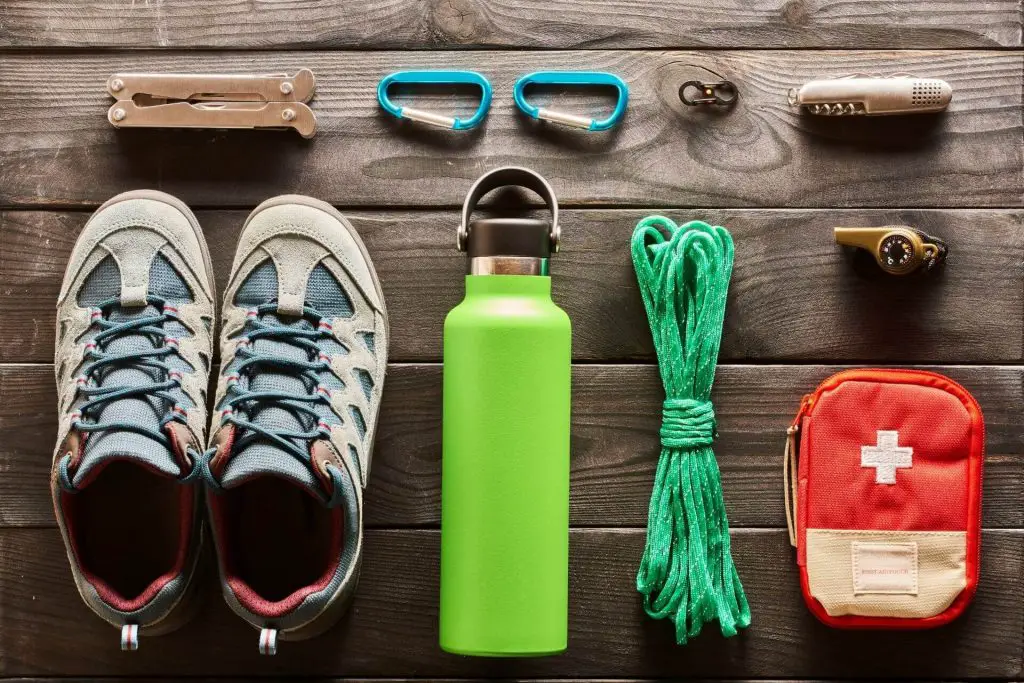Hiking is the best outdoor activity that demands fitness and stamina.
As a novice hiker, the first question that comes to mind is how to train for hiking? Are there special training programs or exercises that help build hiking body shape?
Read to the end to know some quick result exercises that build your strength and stamina. You can perform the workout at home with ease and prepare yourself for the big day.

Why Training For Hiking Beneficial?
People with a fit body and average stamina make the mistake of skipping conditioning for hiking routine. Usually, people with good health and shape easily go through a short hiking trip. These trips do not require much effort, and you don’t have to carry a heavy backpack.
Do you want to go for Thru-hiking or accomplish serious miles on the terrain?
It’s best to prepare your body for a challenging task. Here are some of the reasons you should opt for a hiking workout plan.
- It helps in strengthening and stabilizing your joint
- You can improve your cardiovascular endurance.
- Enhancing muscle strength
- You can have more fun with a fit body than with a tiring one after a few hours.

How To Train For Hiking?
Some novice hikers often advise that the best conditioning for hiking is a practice hike.
However, rehearsal hiking is a crucial aspect of hiking training. But it’s impossible to prepare your body for a hike on short hiking trips.
The experts recommend a hiking training plan that includes a series of strengthening exercises. It’s beneficial to add stretching, strolling, swimming, running, and cycling to the routine.
Rehearsal/Practice Hiking
Rehearsal or practice hiking is the best exercise for a hiking training program. You can start with a short hike and increase the duration gradually to build up stamina.
Short hike
Duration: 1 to 2 hours
Walking speed: fast enough to make your heart race
Hiking trail: start with flat trails and then move to challenge steep trails.
Tips: You can find a time that is convenient for hiking before or after work. You can add weight to your backpack and gradually add more on each trip. Start with a daypack and then switch to a full-size backpack. In the final weeks of training, try to hike with a backpack fully loaded with hiking essentials.
Training for long-distance hiking
Duration: 2 to 6 hours
Walking speed: normal or moderate
Hiking trail: choose steep trails that are challenging
Tips: It’s recommended to go for a long hike every week when training for the big day. Increase the weight in your backpack on every trip. Your aim should be hiking in a fully loaded backpack in the final week of training. Keep increasing the distance and the level of terrain difficulty every week to enhance your strength and stamina.

How To Prepare For A Hike With Circuit Training
Why opt for circuit training when you’re preparing for hiking trips? They are sharp, short, and, most importantly, highly effective. You can fit them into your busy routines.
Strength training for hiking is super essential for improving endurance and preventing injuries during hiking.
The circuit training program includes highly effective strength exercises to prepare for the main event.
Strengthening exercises performed as circuits improve not only stamina and fitness but also cardiovascular endurance.
The circuit training could be done at the home, beach, park with minimal equipment. Here is a listing of exercises and their sets to make things easier for beginners.
Note: Minimize rest break to 20 seconds for higher effectiveness.
- Step Ups 20 times on one leg and then the other.
- Banded side steps 20 times in both directions.
- Band Pulls apart 18 to 20 times.
- Bulgarian split squat 10 to 12 times, one leg at a time
- Lateral Step-up 15 to 20 time one leg at a time
- Walking Lunges 18 to 20 times
When one set of exercises complete, take some rest for 2 to 3 minutes. It’s best to repeat the circuit at least 2 to 3 sets.
Tip For Experts: To make this circuit more cardio-intensive, add the mountain climbers 20 times in between.
Strength exercises for hiking: You have learned how to do a circuit of exercises. It’s time to indulge in the details to know how each exercise is performed.
Mountain Climbers: Mountain climbers are usually done in two ways.
1. Leg and lung burner:
- Begin with printer position, place both hands on the mat, and shoulder aligned above hands.
- Place one foot in between both hands.
- The other leg stretched back behind.
- Jump and switch positions of the foot without removing your hands
2. Core burner:
It’s an amazing core exercise for hiking. You can strengthen your core muscles for a beat hiking experience.
- Begin with a high plank pose
- Draw your right knee to your chest
- Pull your right knee to your chest and the left on the floor
- It’s the best exercise for strengthening arms, core, and shoulders.
3. Step-ups
It’s a great workout for challenging terrains and uphill hiking training. It also helps to improve your balance and control of the terrain.
- Put your foot on a knee-high step; it could be a step or sofa in the home.
- Step up with one leg than the other and stand on the step
- Step down with your leading leg down and then other
4. Banded side steps
Hiking is not a straight path; you have to step right and left on the terrain.
- Position a band around your thighs or ankles.
- Bend your knees slightly
- Walk sideways in your hall or gym.
- It will strengthen your leg and knee muscles.
5. Hip Thrusters
It’s a great exercise to strengthen your glutes and calves.
- Position your shoulder on the edge of the bench
- Create a 90-degree strengthening knee bend
- Drop your hips down and push up with your glutes
- Hold your position for a second while squeezing your glutes.
6. Bulgarian split squat
It’s the best exercise to make your legs strong for long hikes.
- Position one foot on a step and the other a little forward
- Shoulder aligned with the hips, bend your back knee on the ground.
- Your front thigh should be parallel to the ground.
- Add weights gradually
7. Bands Pull Apart
This hiking workout plan works for strengthening upper back muscles and improving posture.
- Position a resistance band in both hands
- Straight out your arms in the front
- Pull the band apart without bending elbows, forming the letter T.
- The band should be touching your chest.
8. Lateral step-ups
The exercise works best in strengthening the smaller glute muscles and stabilizing knees.
- Stand on a step sideways
- Step up on with foot closest
- Join the other foot on the step and stand straight
- Step down first with the trailing foot
9. Walking lunges
Lunges help in strengthening the muscles used during hiking downhill.
- Step ahead into a linger without your knee moving forward of the foot
- Advance your back foot in a big lunge without standing up
- Keep your torso upright.
This how-to train for hiking guide is perfect for beginners. If you don’t know how to train your body for hiking, try these simple exercises and get ready for a challenging hike.
Read Also:
































